 W
WEyewear consists of items and accessories worn on or over the eyes, for fashion or adornment, protection against the environment, and to improve or enhance visual acuity.
 W
WAn active shutter 3D system is a technique of displaying stereoscopic 3D images. It works by only presenting the image intended for the left eye while blocking the right eye's view, then presenting the right-eye image while blocking the left eye, and repeating this so rapidly that the interruptions do not interfere with the perceived fusion of the two images into a single 3D image.
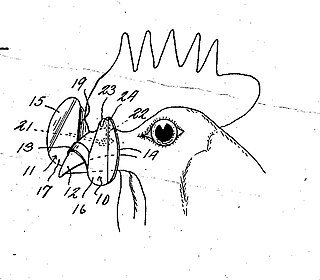 W
WBlinders, also known as peepers, are devices fitted to, or through, the beaks of poultry to block their forward vision and assist in the control of feather pecking, cannibalism and sometimes egg-eating. A patent for the devices was filed as early as 1935. They are used primarily for game birds, pheasant and quail, but also for turkeys and laying hens. Blinders are opaque and prevent forward vision, unlike similar devices called spectacles which have transparent lenses. Blinders work by reducing the accuracy of pecking at the feathers or body of another bird, rather than spectacles which have coloured lenses and allow the bird to see forwards but alter the perceived colour, particularly of blood. Blinders are held in position with a circlip arrangement or lugs into the nares of the bird, or a pin which pierces through the nasal septum. They can be made of metal (aluminium), neoprene or plastic, and are often brightly coloured making it easy to identify birds which have lost the device. Some versions have a hole in the centre of each of the blinders, thereby allowing restricted forward vision.
 W
WA blindfold is a garment, usually of cloth, tied to one's head to cover the eyes to disable the wearer's sight. While a properly fitted blindfold prevents sight even if the eyes are open, a poorly tied or trick blindfold may let the wearer see around or even through the blindfold.
 W
WBrowline glasses are a style of eyeglass frames where the "bold" upper part holding the lenses resembles eyebrows framing the eyes. They were very popular during the 1950s and 1960s, especially in the United States of America. The glasses were first manufactured by Shuron Ltd in 1947 under the "Ronsir" brand, and quickly emulated by various other manufacturers. The design became the most common style of eyeglasses throughout the 1950s and the early 1960s before it was surpassed in popularity by solid plastic styles. Browlines enjoyed a renaissance as sunglasses in the 1980s before returning to popularity in the 2010s, with the rise of retro style and the hipster subculture.
 W
WCat eye glasses are a shape of eyewear. The form is closely related to the browline style, differentiated by having an upsweep at the outer edges where the temples or arms join the frame front. They were mainly popular in the 1950s and 1960s among women and are often associated with the Beehive hairstyle and other looks of the period. They preceded the large bug-eye glasses of the 1970s, 1980s, and 1990s. Notable wearers of cat eye glasses include: Audrey Hepburn, Barry Humphries as Dame Edna Everage, Jane Jacobs, Amy Lamé, Lisa Loeb, Dinah Manoff, Elizabeth Taylor, Marilyn Monroe, Mary Whitehouse, and Barbara Windsor.
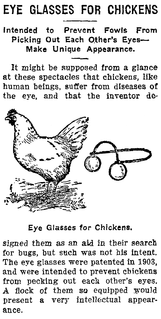 W
WChicken eyeglasses, also known as chickens specs, chicken goggles, generically as pick guards and under other names, were small eyeglasses made for chickens intended to prevent feather pecking and cannibalism. They differ from blinders as they allowed the bird to see forward whereas blinders do not. One variety used rose-colored lenses as the coloring was thought to prevent a chicken wearing them from recognizing blood on other chickens which may increase the tendency for abnormal injurious behavior. They were mass-produced and sold throughout the United States as early as the beginning of the 20th century.
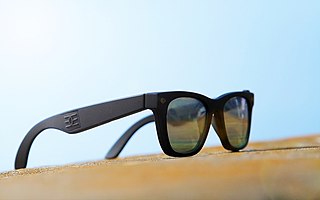 W
WEpiphany Eyewear are smartglasses developed by Vergence Labs. The glasses record video stored within the glasses' hardware for live-stream upload to a computer or social media. The glasses use smartphone technology. The head mounted display is a mobile computer and a high-definition camera. The glasses take photographic images, record or stream video to a smartphone or computer tablet.
 W
WAn eyepatch is a small patch that is worn in front of one eye. It may be a cloth patch attached around the head by an elastic band or by a string, an adhesive bandage, or a plastic device which is clipped to a pair of glasses. It is often worn by people to cover a lost or injured eye, but it also has a therapeutic use in children for the treatment of amblyopia (See orthoptics and vision therapy). Eyepatches used to block light while sleeping are referred to as a sleep mask. Eyepatches associated with pirates are a stereotype originating from fiction.
 W
WAn EyeTap is a concept for a wearable computing device that is worn in front of the eye that acts as a camera to record the scene available to the eye as well as a display to superimpose computer-generated imagery on the original scene available to the eye. This structure allows the user's eye to operate as both a monitor and a camera as the EyeTap intakes the world around it and augments the image the user sees allowing it to overlay computer-generated data over top of the normal world the user would perceive.
 W
WGI glasses are eyeglasses issued by the American military to its service members. Dysphemisms for them include the most common "birth control glasses" and other variants. At one time, they were officially designated as regulation prescription glasses, or RPGs. This was commonly said to mean "rut prevention glasses" due to their unstylish appearance.
 W
WGlasses, also known as eyeglasses or spectacles, are vision eyewear, consisting of glass or hard plastic lenses mounted in a frame that holds them in front of a person's eyes, typically utilizing a bridge over the nose and hinged arms which rest over the ears.
 W
WThe Sony Glasstron was a family of portable head-mounted displays, first released in 1996 with the model PLM-50. The products included two LCD screens and two earphones for video and audio respectively. These products are no longer manufactured nor supported by Sony.
 W
WGoggles, or safety glasses, are forms of protective eyewear that usually enclose or protect the area surrounding the eye in order to prevent particulates, water or chemicals from striking the eyes. They are used in chemistry laboratories and in woodworking. They are often used in snow sports as well, and in swimming. Goggles are often worn when using power tools such as drills or chainsaws to prevent flying particles from damaging the eyes. Many types of goggles are available as prescription goggles for those with vision problems.
 W
WGoggleWorks Center for the Arts is a community art and cultural resource center located in Reading, Pennsylvania. The mission of the GoggleWorks is “to transform lives through unique interactions with art.”
 W
WDeveloped at Kopin Corporation by a team led by Jeffrey Jacobsen, Chief Golden-i Architect and Senior Advisor to CEO, the Golden-i platform consists of multiple mobile wireless wearable headset computers operated by voice commands and head movements. Utilizing a speech controlled user interface and head-tracking functionality, Golden-i enables the user to carry out common computer functions whilst keeping their hands free.
 W
WA head-mounted display (HMD) is a display device, worn on the head or as part of a helmet, that has a small display optic in front of one or each eye. An HMD has many uses including gaming, aviation, engineering, and medicine. Virtual reality headsets are HMDs combined with IMUs. There is also an optical head-mounted display (OHMD), which is a wearable display that can reflect projected images and allows a user to see through it.
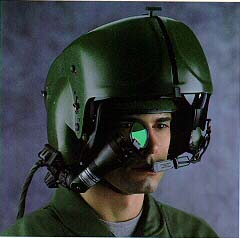 W
WA helmet-mounted display (HMD) is a device used in aircraft to project information to the pilot's eyes. Its scope is similar to that of head-up displays (HUD) on an aircrew's visor or reticle. An HMD provides the pilot with situation awareness, an enhanced image of the scene, and in military applications cue weapons systems, to the direction their head is pointing. Applications which allow cuing of weapon systems are referred to as helmet-mounted sight and display (HMSD) or helmet-mounted sights (HMS).
 W
WHorn-rimmed glasses are a type of eyeglasses. Originally made out of either horn or tortoise shell, for most of their history they have actually been constructed out of thick plastics designed to imitate those materials. They are characterized by their bold appearance on the wearer's face, in contrast to metal frames, which appear less pronounced.
 W
WA lorgnette is a pair of spectacles with a handle, used to hold them in place, rather than fitting over the ears or nose. The word lorgnette is derived from the French lorgner, to take a sidelong look at, and Middle French, from lorgne, squinting. They became popularized by Englishman George Adams when he designed a practical case meant to be carried in the pocket.
 W
WA monocle is a type of corrective lens used to correct or enhance the visual perception in only one eye. It consists of a circular lens, generally with a wire ring around the circumference that can be attached to a string or wire. The other end of the string is then connected to the wearer's clothing to avoid losing the monocle. The antiquarian Philipp von Stosch wore a monocle in Rome in the 1720s, in order to closely examine engravings and antique engraved gems, but the monocle did not become an article of gentlemen's apparel until the 19th century. It was introduced by the dandy's quizzing glass of the 1790s, as an article of high fashion.
 W
WThe Musée des Lunettes et Lorgnettes Pierre Marly is a museum of eyeglasses located in the 1st arrondissement of Paris, France, at 380 rue Saint-Honoré. It is open Tuesday through Saturday; an admission fee is charged.
 W
WNew Year's glasses are novelty eyeglasses in the numerical shape of the coming year usually worn during New Year's Eve parties. They were invented and patented by Richard Sclafani and Peter Cicero in 1990, although other companies have produced similar versions. New Year's glasses' inspiration and popularity arose from the fact that the two digits in the middle of the year number had holes suitable for looking through or mounting lenses into.
 W
WPince-nez is a style of glasses, popular in the late 19th and early 20th centuries, that are supported without earpieces, by pinching the bridge of the nose. The name comes from French pincer, "to pinch", and nez, "nose".
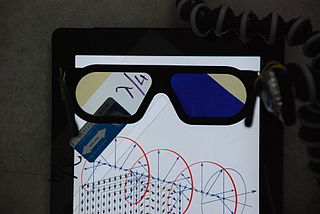 W
WA polarized 3D system uses polarization glasses to create the illusion of three-dimensional images by restricting the light that reaches each eye.
 W
WRimless eyeglasses, are a type of eyeglasses in which the lenses are mounted directly to the bridge and/or temples. The style is divided into two subtypes: three-piece glasses are composed of lenses mounted to a bridge and two separate temple arms, while rimways feature a supporting arch that connects the temples to the bridge and provides extra stability for the lenses.
 W
WScissors-glasses are eyeglasses, normally used to correct distance-vision, mounted on scissoring stems rather than on temple stems as modern eyeglasses are.
 W
WShooting glasses are specialized corrective glasses for use in shooting and are used almost exclusively in sport shooting competitions. Like other glasses, they are worn in front of the eyes to compensate for the shooter's ametropia with optical lenses.
 W
WShutter shades, also known as slatted shades, louvered shades, or Venetian blind shades are sunglasses that, instead of having darkened lenses, have horizontal slats similar to window shutters, which are an integral part of the frame.
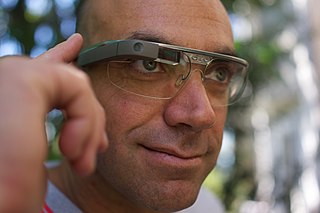 W
WSmartglasses or smart glasses are wearable computer glasses that add information alongside or to what the wearer sees. Alternatively, smartglasses are sometimes defined as wearable computer glasses that are able to change their optical properties at runtime. Smart sunglasses which are programmed to change tint by electronic means are an example of the latter type of smartglasses.
 W
WSolar viewer are special eyewear designed for direct viewing of the Sun. Standard sunglasses are unable to filter out eye damaging radiation. Solar viewers are required for safe viewing of solar events such as eclipses. The recommended optical density of this eyewear is 5.
 W
WSunglasses or sun glasses are a form of protective eyewear designed primarily to prevent bright sunlight and high-energy visible light from damaging or discomforting the eyes. They can sometimes also function as a visual aid, as variously termed spectacles or glasses exist, featuring lenses that are colored, polarized or darkened. In the early 20th century, they were also known as sun cheaters.
 W
WWindsor glasses are a type of eyeglasses characterised by circular or nearly circular eyerims and a thin metal frame. The style emerged in the 19th century and first became popular in the 1880s. Traditionally the bridge of Windsor glasses is a 'saddle', and hence to prevent the glasses slipping off the face the temples are 'riding bow temples' ; however, in a modern and extended definition, Windsors typically have a bridge with nose pads and gently curved temples.